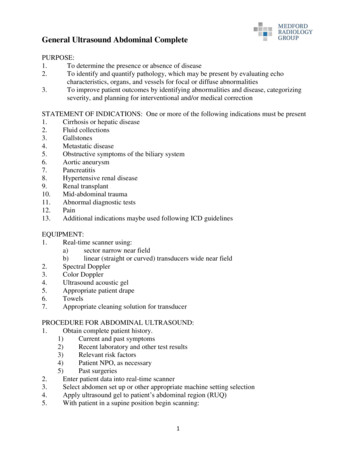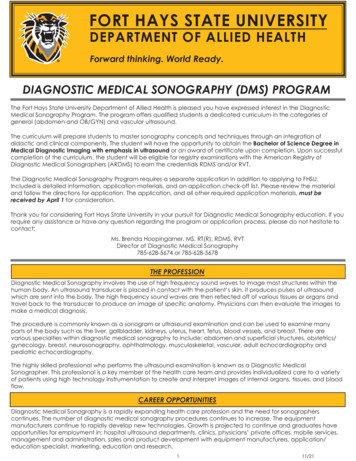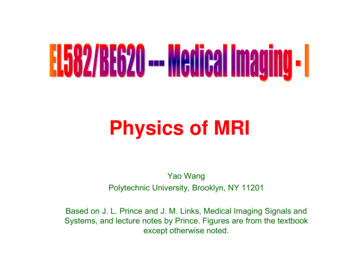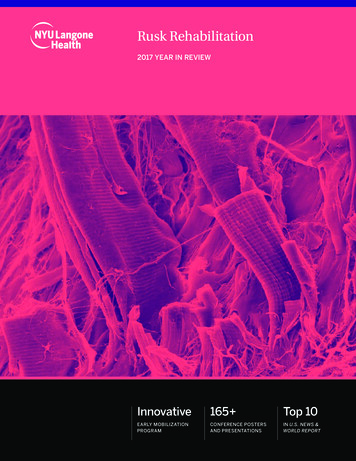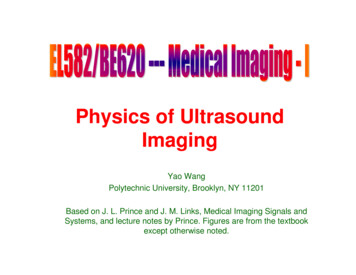
Transcription
Physics of UltrasoundImagingYao WangPolytechnic University, Brooklyn, NY 11201Based on J. L. Prince and J. M. Links, Medical Imaging Signals andSystems, and lecture notes by Prince. Figures are from the textbookexcept otherwise noted.
Lecture Outline Ultrasound imaging overview General characterization of acoustic wave Wave equation– 3D– Plane wave– Spherical wave Reflection of waveAbsorption and scattering of waveDoppler effectField pattern of a transducerEL5823 Ultrasound PhysicsYao Wang, Polytechnic U., Brooklyn2
Ultrasound Imaging Measure the reflectivity of tissue to sound wavesCan also measure velocity of moving objects, e.g. blood flow (Dopplerimaging)No radiation exposure, completely non-invasive and safeFastInexpensiveLow resolutionMedical applications: imaging fetus, heart, and many othersEL5823 Ultrasound PhysicsYao Wang, Polytechnic U., Brooklyn3
What is Acoustic Wave Pressure waves that propagate through matter viacompression and expansion o the material– Generated by compressing and releasing a small volume oftissue Longitudinal wave– Particles in the medium move back and force in the samedirection that the wave is traveling Shear Wave– Particles move at right angles to the direction of the wave– Not used for medical ultrasound imagingEL5823 Ultrasound PhysicsYao Wang, Polytechnic U., Brooklyn4
Longitudinal WaveFrom Graber: Lecture note for BMI F05From Prince, Lecture noteEL5823 Ultrasound PhysicsYao Wang, Polytechnic U., Brooklyn5
EM vs Acoustic Wave Electromagnetic– Self propagating, consisting of electric and magnetic componentsoscillating at right angles to each other, and to the direction ofpropagation– Does not require a material medium through which to propagate– Classification (increasing in frequency, decreasing in wavelength): radio, microwave, infrared, visible light, ultraviolet, x-ray, gamma ray Acoustic– Pressure waves that propagate through matter via compression andexpansion of the material– Requires a material medium through which to propagate– Classification (increasing in frequency): Infra sound, audible sound, ultrasoundEL5823 Ultrasound PhysicsYao Wang, Polytechnic U., Brooklyn6
Transfer and Transformation of Energy Light becomes sound — photoacoustic phenomena Sound becomes light — sonoluminescence Absorbed electromagnetic (EM) and acoustic energyboth become heat Nevertheless, EM and acoustic energy areFUNDAMENTALLY DISTINCT PHENOMENA!EL5823 Ultrasound PhysicsYao Wang, Polytechnic U., Brooklyn7
Acoustic Wave Energy RangesInfrasoundAudible20 HzUltrasound20 kHz Just as there are infrared, visible, and ultraviolet ranges in the EMspectrum, so there are infrasound (“infra” “below,” “beneath”),audible (i.e., sound) and ultrasound (“ultra” “beyond,” “above”)ranges of acoustic wave frequencies Note that the ratio of the highest to the lowest audible frequencies is103, or almost 10 octaves. On the other hand, the ratio of thehighest to the lowest frequencies of visible light is a bit less than 2(i.e., less than one octave).EL5823 Ultrasound PhysicsYao Wang, Polytechnic U., Brooklyn8
Characterization of Acoustic Wave Speed of sound in a medium depends on the medium propertyc 1κρ ; κ :compressibility; ρ : density Air: 330 m/s; water, c 1480; most tissue: 1500 m/s; bone: 4080 m/s Particle displacement velocity (v)– Note that particle speed v is different from sound speed c! Acoustic pressure (p):p Zv– Analogy: p: voltage, v: current, Z: impedance ρCharacteristic impedance of a medium: Z ρc κ– Unit: kg/m 2s or rayls (after Lord Rayleigh)EL5823 Ultrasound PhysicsYao Wang, Polytechnic U., Brooklyn9
Acoustic energy and intensity Particles in motion have kinetic energy; those poised for motionhas potential energy1 2wk ρv Kinetic energy density:2 Potential energy density: Acoustic energy density:1w p κp 22w wk w p Acoustic intensity (acoustic energy flux):p2I pv Z– Analogy: I (power), p (voltage), v (current)EL5823 Ultrasound PhysicsYao Wang, Polytechnic U., Brooklyn10
Acoustic Properties of Common MaterialNotice how similarthese values areto each other andto that for water,metalgasacrylicand how differentthey are fromthese.soft tissueshard tissueFrom [Graber: Lecture note for BMI F95]Table 10.1 in [Prince] gives more information, includingdensity and absorption coefficientEL5823 Ultrasound PhysicsYao Wang, Polytechnic U., Brooklyn11
3D Wave EquationEL5823 Ultrasound PhysicsYao Wang, Polytechnic U., Brooklyn12
Plane WaveForward traveling waveBackward traveling waveOne of them may be zeroEL5823 Ultrasound PhysicsYao Wang, Polytechnic U., Brooklyn13
Example An ultrasound transducer ispointing down the z axis.Starting at time t 0, itgenerates an acoustic pulsewith formφ (t ) (1 e t /τ )e t /τ12 Assume the speed of thesound in the tissue is c 1540m/s. What is the forwardtraveling wave down the zaxis? At what time does theleading edge of the impulse hitthe interface 10 cm away fromthe transducer?EL5823 Ultrasound Physicsφ f ( z, t ) φ (t z / c) (1 e (t z / c ) /τ 1 )e ( t z / c /τ 2T 0.1m / 1540 64.9 µsYao Wang, Polytechnic U., Brooklyn14
Harmonic Waves Harmonic plane wave:p( z , t ) cos(k ( z ct )) Viewed at a fixed particle, the pressure changes in time with frequencyft kc/2π (cycles/s)Viewed at a fixed time, the pressure changes in z with frequency fz k/2π– k is called wavenumber Wavelength is the spacing between peak or valleys of the wave at anytime– λ 1/fz 2π/k c/ft (approximately) Harmonic wave are widely used in ultrasound imagingGiven ft, the wavelength depends c, which in turn depends on the tissueproperty!– Wavelength determines the resolution of ultra sound imaging– Ex: ft 3.5 MHz, c 1540m/s (most tissue), λ 0.44mmEL5823 Ultrasound PhysicsYao Wang, Polytechnic U., Brooklyn15
Spherical WaveEL5823 Ultrasound PhysicsYao Wang, Polytechnic U., Brooklyn16
Reflection and Refraction: GeometricCharacteristicsEL5823 Ultrasound PhysicsYao Wang, Polytechnic U., Brooklyn17
Reflection and Refraction: EnergyCharacteristics Particle motion conservation– Tangential particle motion caused by the incident wave sum of particlemotions of transmitted and reflected wavesvi cos θ i vr cos θ r vt cos θ t Pressure conservationpt pr pi Based on above equations, and the relation p Zv, one can deriverelation of pr and pt with pi, and consequently pressure reflectivityand pressure transmitivity defined in the next slideEL5823 Ultrasound PhysicsYao Wang, Polytechnic U., Brooklyn18
Reflected and Refracted WaveEL5823 Ultrasound PhysicsYao Wang, Polytechnic U., Brooklyn19
Example Layered medium, determine total reflected signal frommultiple layersZ1pt3pr1 piZ2pt1Z3pt2EL5823 Ultrasound PhysicsTotal reflected signal pr1 pt3pr2Yao Wang, Polytechnic U., Brooklyn20
Energy Attenuation due to Absorptionand Scattering The pressure of an acoustic wave decreases as thewave propagates due to– Absorption The wave energy is converted to thermal energy Two forms– Classical: due to frictions between particles as the wave propagates– Relaxation: due to particle motion to return (relax) to original positionafter displacement by the wave pressure– Scattering When the sound wave hits an object much larger than itswavelength, reflection occurs. When the object size wavelength, scattering occur (reflection inall directions) Note the difference between reflection and scattering!EL5823 Ultrasound PhysicsYao Wang, Polytechnic U., Brooklyn21
Overall Attenuation Absorption and scattering together causes the pressure and intensity of asound wave to decrease exponentially in the propagation distance zSuppose p(0, t ) A0 f (t )No attenuation : p ( z , t ) A0 f (t c 1 z )With attenuation : p( z , t ) A0 e µ a z f (t c 1 z )µ a : Amplitude attenuation factor [cm -1 ]Attenuation coefficient in dB :α 20(log10 e )µ a 8.7 µ a [dB/cm] The attenuation coefficient depends on the frequency of the wave,bgenerally α afRough approximation (1 MHz f 10MHz): b 1, α afSee Table 10.2 in textbook for “a” value for biological tissues(much larger for bone and lung)EL5823 Ultrasound PhysicsYao Wang, Polytechnic U., Brooklyn22
Example Same layered medium as before, but considering theattenuationZ1L2pt3pr1 piZ2,µ2pt1Z3pt2EL5823 Ultrasound PhysicsTotal reflected signal pr1 pt3pr2Yao Wang, Polytechnic U., Brooklyn23
Scattered Signal When the sound wave hits an object much smaller than sound wavelength,scattering occur (reflection in all directions), giving rise to spherical wavesConsider a plane wave traveling in z, hitting a small target at z d Source wavep ( z , t ) A0 f (t c 1 z )EL5823 Ultrasound PhysicsYao Wang, Polytechnic U., Brooklyn24
Doppler Effect: Moving source Doppler effect: change in frequency of sound due to the relativemotion of the source and receiver Case 1: moving source (scatterer), stationary receiver (transducer)– Source moving away, wavelength longer, lower freq– Source moving closer, wavelength shorter, higher freq.source (freq f o )moving with speed v opposit the wave direction :one period T 1/f ocrest in wave moves a distance of cT c/f o without source motionsource moves a distance of vT v/f oWith source motion, crest moves a distance (equivalenth wavelength λT ) of cT vTEquivalent temporal frequency isfT cλT cfoc vGeneral case :source moving in a direction θ :(angle between source- receiver vector and source motion vector)cfOc v cos θDoppler frequency :fT v cos θv cos θfO fOc v cos θcθ 0 : source moving away from receiver, f D 0f D fT f O θ 0 : source moving towards receiver, f D 0EL5823 Ultrasound PhysicsYao Wang, Polytechnic U., Brooklyn25
Doppler Effect: Moving Receiver Case 2: stationary source (transducer), moving receiver (target)––––Transducer transmitting a wave at freq fs, wavelength c/fsObject is a moving receiver with speed v, with angle θTarget moving away (θ 0), sound moves slowerTarget moving closer (θ 0), sound moves fasterc v cos θfScDoppler frequency :v cos θf D fO f S fScθ 0 : source moving away from receiver, f D 0fO θ 0 : source moving towards receiver, f D 0EL5823 Ultrasound PhysicsYao Wang, Polytechnic U., Brooklyn26
Doppler Effect for Transducer Transducer:–––––Transmit wave at freq fs to objectObject moves with velocity v at angle θObject receives a wave with freq fo (c vcosq)/c fsThe object (scatterer) reflects this wave (acting as a moving source)Transducer receives this wave with freqcc v cos θfT fO fSc v cos θc v cos θ– Doppler freq 2v cos θ2v cos θf D fT f S fS fSc v cos θcDopper-shift velocimeter: as long as θ not eq 90 0, can recover objectspeed from doppler freq.Doppler imaging: display fD in space and time–EL5823 Ultrasound PhysicsYao Wang, Polytechnic U., Brooklyn27
Schematic of an Ultrasound ImagingSystemEL5823 Ultrasound PhysicsYao Wang, Polytechnic U., Brooklyn28
Functions of transducer Used both as Transmitter And Receiver Transmission mode: converts an oscillating voltage intomechanical vibrations, which causes a series of pressurewaves into the body Receiving mode: converts backscattered pressurewaves into electrical signalsEL5823 Ultrasound PhysicsYao Wang, Polytechnic U., Brooklyn29
Single Crystal Transducer (Probe)(damping)EL5823 Ultrasound PhysicsYao Wang, Polytechnic U., Brooklyn30
Piezoelectrical Crystal Converting electrical voltage to mechanical vibration and vice versaThe thickness of the crystal varies with the applied voltageWhen an AC voltage is applied across the opposite surface of the crystal,the thickness oscillates at the same frequency of the voltageExamples of piezoelectric Materials:– Crystalline (quartz), Polycrystalline ceramic (PZT, lead zirconium titanate),Polymers (PVDF)– PZT is more efficient in converting between electric signal and pressure wave The crystal vibrates sinusoidally after electrical excitation has ended(resonate)––––Resonant frequency f c /2d (d thickness)Practical system: 1-20 MhzThis is the frequency of the pressure wave introduced into the bodyThe damping material damps the vibration after 3-5 cycles When the diameter D of the surface is much larger than d, longitudinalwaves are transmitted into the body The crystal is shaped into a disk or rectangle, with either flat or concavesurfaceEL5823 Ultrasound PhysicsYao Wang, Polytechnic U., Brooklyn31
Piezoelectrical EffectEL5823 Ultrasound PhysicsYao Wang, Polytechnic U., Brooklyn32
Matching Layer To provide acoustic couplingbetween the crystal and patientskin and to protect surface of thecrystalZ of PZT (ZT) is about 15 times ofZ of skin (ZL)– Placing crystal directly over skinwould result a large amount ofenergy be reflected back from theboundaryZLZTTransducerLoad (tissue) R (ZL-ZT)/(ZL ZT) 1Matching layerZL– layer thickness λ/4ZlZ l ZT Z LProblems: Finding material withexact Zl value– Dual-layer:Z l ,1 Z T3/ 4 Z 1/L 4 ;EL5823 Ultrasound PhysicsZ l ,2 Z 1/T 4 Z L3/ 4Yao Wang, Polytechnic U., BrooklynLoad (Target) ZTTransducer– Maximize energy transfer into thebody– Show as a homeworkMatchingLayer 33
Continuous Wave vs Pulsed Continuous wave (CW) Ultrasound– The voltage signal applied to the transducer is a continuoussinusoid signal Pulsed Ultrasound– A pulsed signal is introduced (more common), allowing toseparate reflected signal from targets at different distancesbased on time delayEL5823 Ultrasound PhysicsYao Wang, Polytechnic U., Brooklyn34
Typical Transmit PulseEL5823 Ultrasound PhysicsYao Wang, Polytechnic U., Brooklyn35
Flat (Piston) Plate TransducerNear field boundary (NFB)Fresnel region Fraunhofer region(far field, beam spreading)Vibrating flat plateGeometricapproximation:Wave is confined ina cylinderEL5823 Ultrasound PhysicsD24λYao Wang, Polytechnic U., Brooklyn36
At border of the beam width, the signal strength drops bya factor of 2, compared to the strength on the z-axis Beam width determines the imaging resolution (lateralresolution). Smaller D is good only before far field D 1 5 cm in practice, very poor lateral resolution Focused plate is used to produce narrow beamEL5823 Ultrasound PhysicsYao Wang, Polytechnic U., Brooklyn37
Axial and lateral resolution Axial resolution 0.5 τ c, determined byτ pulse duration.Pulse length determined by location of -3dB point. Lateral resolution determined by beamwidth (-3 dB beam width or - 6 dB width)EL5823 Ultrasound PhysicsYao Wang, Polytechnic U., Brooklyn38
Focused Transducer Beam focusing can be accomplished by– Using a crystal with a curved surface– Placing a concave lens in front of the crystalGood resolution at the focal depth, but worse at smaller or larger distances than flat transducer,Diverges more quickly after the focal pointEL5823 Ultrasound PhysicsYao Wang, Polytechnic U., Brooklyn39
Transducer Array With a single crystal, manual or mechanical steering ofthe beam is needed to produce a two-dimensional image Practical systems today use an array of smallpiezoelectric crystals– Allow electronic steering of the beam to optimize the lateralresolutionEL5823 Ultrasound PhysicsYao Wang, Polytechnic U., Brooklyn40
Transducer ArrayEL5823 Ultrasound PhysicsYao Wang, Polytechnic U., Brooklyn41
Transducer arrays Linear sequential array lateral scan Linear phased array for beam steering,focusingEL5823 Ultrasound PhysicsYao Wang, Polytechnic U., Brooklyn42
Array typesa) Linear Sequential(switched) 1 cm 10-15cm, up to 512 elementsb) Curvilinearsimilar to (a), wider field ofviewc) Linear Phasedup to 128 elements, smallfootprint cardiac imagingd) 1.5D Array3-9 elements in elevationallow for focusinge) 2D PhasedFocusing, steering in bothdimensionsEL5823 Ultrasound PhysicsYao Wang, Polytechnic U., Brooklyn43
Summary What is acoustic wave? Characterization of wave:– Material properties: k, ρ, c, Z– Wave properties: particle velocity v, pressure p, intensity I Plane wave vs. Spherical waveReflection and refraction of wave at an interfaceScattering of waveTransducer for ultrasound imaging–––––––Piezoelectric crystalResonance frequency (determined by thickness of crystal)Flat surface vs. focusedBeam divergence in both types of transducerBeam width determines lateral resolutionPulse period determines axial resolutionArray transducerEL5823 Ultrasound PhysicsYao Wang, Polytechnic U., Brooklyn44
Reference Prince and Links, Medical Imaging Signals and Systems,Chap. 10 (Sec. 10.5 not required),11.2,11.3 A. Webb, Introduction to Biomedical Imaging, Chap. 3EL5823 Ultrasound PhysicsYao Wang, Polytechnic U., Brooklyn45
Homework Reading:– Prince and Links, Medical Imaging Signals and Systems, Chap. 10(Sec. 10.5 not required),11.2,11.3 Note down all the corrections for Ch. 10,11 on your copy of thetextbook based on the provided errata (see Course website orbook website for update). 0.8P10.10P10.12P10.13Considering the matching layer in a transducer. Show that, when amatching layer of depth λ/4 is used, the transmitted energy into thetissue is maximized with an impedance of Z Z ZlEL5823 Ultrasound PhysicsYao Wang, Polytechnic U., BrooklynTL46
When the sound wave hits an object much larger than its wavelength, reflection occurs. When the object size wavelength, scattering occur (reflection in all directions) Note the difference between reflection and scatteri



